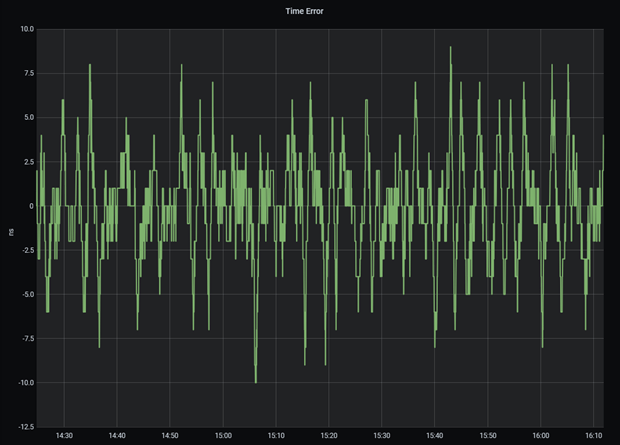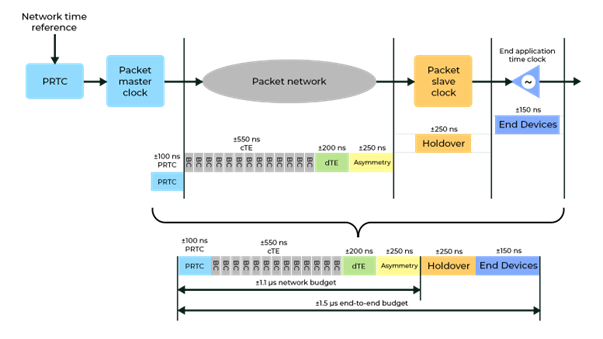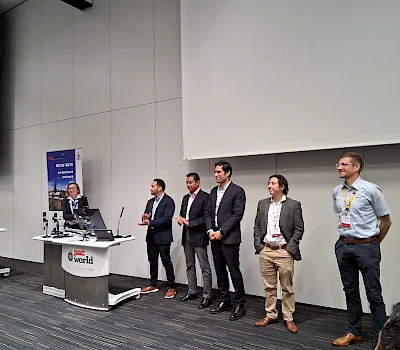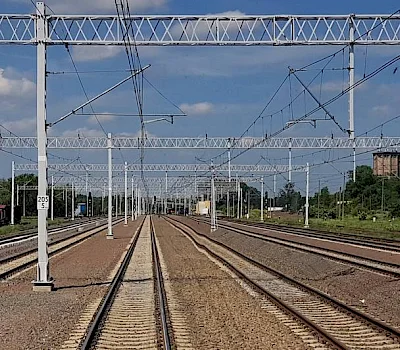Figure 3 shows the path that a timestamp from ePRTC must take to reach the end application. Each network element needs its own time to further transport the timing information, hence each element contributes some delay. According to the IEEE 1588 standard and the recommendations of ITU-T G.8271 on timing and phase synchronisation aspects of telecommunications networks and ITU-T G.8271.1 on network constraints for timing synchronisation in packet-switched networks with full support for clocking from the network, for a 5G telecommunications network to work properly, the (current) network timing budget must be ±1.1 µs and the end-to-end communication delay must be limited to ±1.5 µs. For future-proof MIMO technology, such delay will have to be ±130 ns or even ±65 ns at most. These are not requirements for the customer or the applications that 5G will support, just requirements for 5G to work at all. Such small and precise timeframes cannot be achieved without careful network monitoring, and network monitoring cannot be achieved without a good monitoring probe.
What can be found in the monitoring probe…
A common solution on the market is monitoring probes embedded in the time server. However, this is a problematic solution due to the proverbial judgement in its own right. Unless the probes are differentially connected to each other, if the wrong time reference is flowing, the probe still gives information that all is well. The solution to the problem is to choose an external monitoring probe such as the Quazar 700, which gives 100% confidence that the data we are presented with is a representation of the actual state.
Each monitoring probe should in theory have similar capabilities and give similar results. However, in practice, there are large differences between products from different manufacturers. In our offer, you will find a probe that goes beyond these standards and gives you far greater capabilities.
…, and what the Quazar-700 can offer you?
The Quazar-700 is a manageable probe monitoring the quality of network synchronisation with a time server function that crushes most of its competitors’ probes not only in the enormity but also in the usefulness of its functionalities, which few manufacturers can boast:
- High precision and stability thanks to the best oscillators (OCXO, DOCXO or RUBID) and a time synchronisation precision of ±15ns with the GPS module (Clear Sky)
- The ability to carry out real-time monitoring of the measured parameters is a feature that strongly distinguishes the Quazar-700 from its competitors. Real-time data is dumped from the interfaces, which can be analysed quickly and conveniently.
- Rapid detection of PTP/SyncE errors (location and cause) and unstable 5G network operation related to precise time and frequency synchronisation is one of the features most praised by our customers. With the ability to correlate graphs, the Quazar-700 provides great convenience in reading measurements.
- The Quazar-700 allows local archiving of measurements for up to 72h. The probe allows the recording and storage of monitored archive data, and also offers useful placement of this data on graphs and export to a spreadsheet for easy comparison.
- The option to detect jamming and spoofing and report on these events are features that few monitoring probes have.
- Especially for technical services, the Quazar-700 additionally comes in a mobile version with a convenient measurement kit. The kit includes a bag, cable, power supply and dual-band antenna. With this solution, you can conveniently connect to a router or directly to the BTS and start measuring.
For more detailed information about the Quazar-700, we refer you to the device’s sub-page or brief and invite you to contact us.
Summary
Monitoring time errors in time-sensitive networks is an extremely important aspect of network security and operation – excessive time errors can render the entire system inoperable. In order to prevent such events, monitoring probes have been developed so that this value can be monitored and corrected if necessary. Such an important task should not be delegated to any probe that may simply misrepresent the actual state of the network. It is worth sacrificing a little more for such a probe, which will not only correctly indicate the existence (or absence) of a problem, but also help to localise and rectify it. After all, the performance of critical systems is put at stake….













